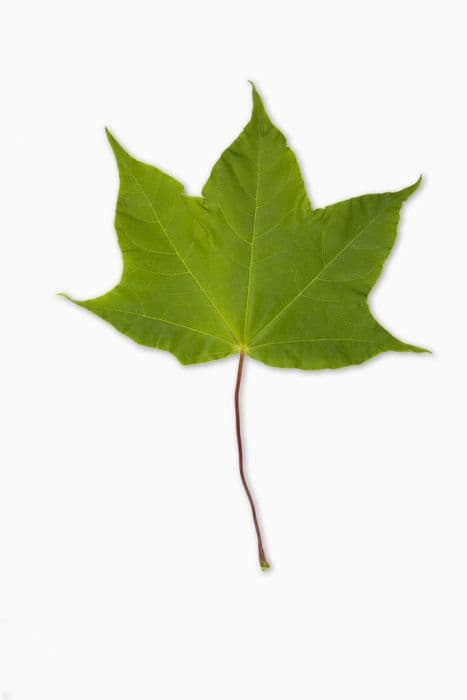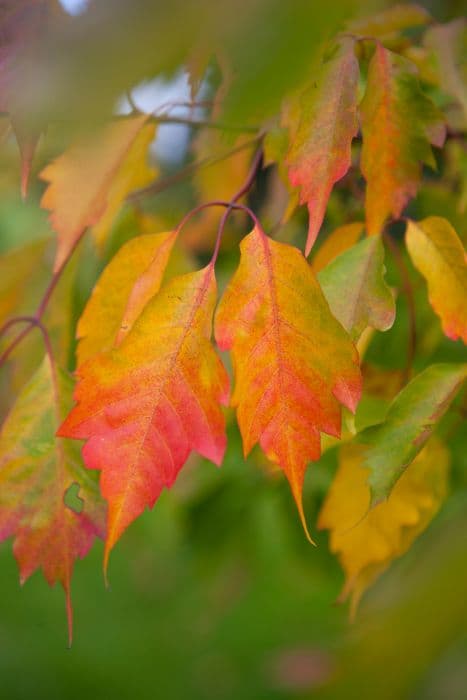Redvein Maple Acer rufinerve 'Erythrocladum'

ABOUT
The Acer rufinerve 'Erythrocladum', commonly known as the Redvein Maple, is a visually striking plant known for its distinctive foliage and bark. The leaves of the Redvein Maple exude vibrancy throughout the seasons. In the spring and summer, the leaves boast a bright green hue with reddish veins that really stand out against the green backdrop of the leaf. As the colder months approach, the foliage undergoes a dramatic change, transforming into a rich blend of yellow, orange, and red colors, providing a spectacular autumn display. What sets this maple apart is the unusual appearance of its bark. The bark has a pronounced snake-like pattern that adds interest, especially during the winter months when the leaves have fallen and the branches are bare. These characteristic marks on the bark are where the Redvein Maple gets its name. The bark coloration includes greens and grays offset by reddish-brown streaks, adding a unique texture and color palette to the garden throughout the year. The branches and twigs are also noteworthy, particularly in the colder months, as they take on a reddish tinge that further complements the garden's winter scene. This multi-season interest makes the Redvein Maple a favorite among garden enthusiasts who aim to maintain year-round visual appeal in their landscapes. Despite its ornamental charm, the specific physical dimensions of the plant are not addressed in this description as per the request.
About this plant
 Names
NamesFamily
Sapindaceae
Synonyms
Redvein Maple, Japanese Redvein Maple
Common names
Acer rufinerve 'Erythrocladum'.
 Toxicity
ToxicityTo humans
The plant commonly known as Redvein Maple, Acer rufinerve 'Erythrocladum', is not typically known for being poisonous to humans. There are no well-documented cases or reports indicating toxicity upon ingestion of parts of this plant. Therefore, no specific symptoms of poisoning or possible consequences of ingesting any part of the Redvein Maple are generally expected.
To pets
The Redvein Maple, Acer rufinerve 'Erythrocladum', is not known to be toxic to pets. It does not appear on common lists of plants that are poisonous to animals such as cats and dogs. Therefore, ingesting parts of the Redvein Maple should not cause symptoms of poisoning in pets under normal circumstances.
 Characteristics
CharacteristicsLife cycle
Perennials
Foliage type
Deciduous
Color of leaves
Green
Height
20-30 feet (6-9 meters)
Spread
15-25 feet (4.5-7.5 meters)
Plant type
Tree
Hardiness zones
5
Native area
Japan
Benefits
 General Benefits
General Benefits- Visual Interest: Provides striking color with its red-twigged bark, particularly in the winter months.
- Landscape Diversity: Adds variety to the garden with its unique features, enriching the overall aesthetic.
- Shade: Offers a moderate amount of shade in the summer due to its leaf canopy.
- Habitat Support: Can serve as a habitat for local wildlife, offering shelter and food sources.
- Seasonal Changes: Showcases vivid colors throughout the seasons, with leaves changing from green to yellow or red in the fall.
- Cultural Significance: Has been used traditionally in Japanese gardens, representing beauty and elegance.
- Durability: Tolerates a range of soil types and urban pollution, making it versatile for various landscapes.
 Medical Properties
Medical PropertiesThis plant is not used for medical purposes.
 Air-purifying Qualities
Air-purifying QualitiesThis plant is not specifically known for air purifying qualities.
 Other Uses
Other Uses- Photography and Art: The distinctive coral-red bark of the Redvein Maple provides an excellent subject for photographers and artists, especially in winter when the color contrasts starkly with snow.
- Wildlife Shelter: The dense branching can offer shelter for birds and small mammals, particularly during harsh weather conditions.
- Woodworking: Although not commonly used, the wood can be harvested for small woodworking projects, yielding a hard, fine-grained material.
- Educational Tool: Redvein Maple can be used in educational settings, such as arboretums and botanical gardens, to teach about plant identification and the variety within the Acer genus.
- Landscape Design: It's often utilized in landscape design not just for its aesthetic appeal but also for creating natural partitions or screens in gardens.
- Leaf Castings: Leaves of the Redvein Maple can be used for making decorative leaf castings, which capture the intricate vein patterns for ornamental purposes.
- Cultural Symbolism: The tree can be incorporated into gardens or landscapes with a Japanese theme, as maples are a prominent element in Japanese garden aesthetics.
- Tannin Source: The bark contains tannins that can be used for natural dyeing processes, creating various shades of brown or gray.
- Bonsai: Redvein Maple's attractive features make it a candidate for bonsai cultivation, where its bark color and leaf shape can be appreciated on a miniature scale.
- Seasonal Celebrations: Branches of the Redvein Maple can be used as part of decorations for seasonal festivals or celebrations, especially in autumn when the leaves change color.
Interesting Facts
 Feng Shui
Feng ShuiThe Japanese Maple is used in Feng Shui to promote balance and harmony. It’s believed to have a serene energy and can be placed in the garden to enhance the flow of positive chi.
 Zodiac Sign Compitability
Zodiac Sign CompitabilityThe Japanese Maple is not used in astrology practice.
 Plant Symbolism
Plant Symbolism- Resilience: The Acer rufinerve 'Erythrocladum', commonly known as the Grey-budded Snakebark Maple, often symbolizes resilience due to its ability to adapt to various climates and conditions.
- Peace: Maples, in general, are symbols of peace and tranquility, which is why the Grey-budded Snakebark Maple can also be associated with calmness and serenity.
- Balance: With its beautifully colored leaves, this tree embodies the balance of beauty in nature and can symbolize the idea of living in harmony with the environment.
- Longevity: Trees often represent longevity and the Grey-budded Snakebark Maple, being a durable species, contributes to this symbolization through its potential for a long life.
 Water
WaterThe Grey-barked Maple should be watered deeply once a week during the growing season, receiving around 1.5 gallons of water each time, depending on the size and maturity of the tree. In hotter months, it may require more frequent watering, such as twice a week, especially if the weather is particularly dry or windy. During winter, reduce watering to once every two to three weeks as the tree's water requirements decrease. It's crucial to avoid waterlogging, so ensure the soil drains well and adjust your watering routine based on the actual moisture level of the soil, which can be checked with a moisture meter or by feeling the soil about an inch beneath the surface.
 Light
LightThe Grey-barked Maple prefers a spot with full sun to partial shade. Best growth and leaf color are achieved when the tree is planted where it can receive at least four to six hours of direct sunlight daily. However, it is important to protect it from intense afternoon sun in hotter climates to prevent leaf scorch.
 Temperature
TemperatureFor the Grey-barked Maple, the ideal temperature range is between 60°F and 80°F. It can handle temperatures as low as -10°F and as high as 100°F for short periods. It is important to provide protection from harsh winter winds which can damage the tree, especially when temperatures drop below the survival threshold.
 Pruning
PruningPrune the Grey-barked Maple to maintain its shape and health, removing any dead or damaged branches, as well as to improve air circulation. The best time for pruning is late winter or early spring before the sap starts to flow. Pruning once a year is typically sufficient, but always be careful not to remove more than 25% of the tree's canopy at one time.
 Cleaning
CleaningAs needed
 Soil
SoilGrey Snakebark Maple thrives in a well-draining, loamy soil with a pH of 5.5 to 6.5. A mixture of one-third garden soil, one-third peat moss or well-rotted compost, and one-third perlite or coarse sand is ideal. Ensure the soil mix is rich in organic material to support its growth.
 Repotting
RepottingGrey Snakebark Maple should be repotted every 2-3 years to prevent root crowding and replenish soil nutrients. Young trees might require more frequent repotting, whereas mature trees can be repotted less often.
 Humidity & Misting
Humidity & MistingGrey Snakebark Maple prefers moderate to high humidity levels, ideally between 50-70%. Maintaining this humidity range will support leaf health and mimic its natural forest environment.
 Suitable locations
Suitable locationsIndoor
Ensure bright, indirect light and consistent moisture.
Outdoor
Plant in partial shade, sheltered from strong winds.
Hardiness zone
5-7 USDA
 Life cycle
Life cycleThe Acer rufinerve 'Erythrocladum', commonly known as the Redvein Maple, begins its life cycle when the winged samaras (seeds) are dispersed by wind in late spring. After landing in a suitable location with moist soil and partial sunlight, the samaras germinate, and a seedling emerges. Over several years, the seedling grows into a sapling, developing its characteristic green leaves with red veins. As it matures into an adult tree, it produces a dense canopy and reaches reproductive maturity, typically flowering in spring with small, inconspicuous yellow-green flowers that are pollinated by wind. Following pollination, the tree sets seeds, continuing the cycle as new samaras develop and are dispersed by the wind. Throughout its life cycle, the Redvein Maple undergoes seasonal changes, with leaves turning various shades of yellow, orange, or red in autumn before they are shed in preparation for winter dormancy.
 Propogation
PropogationPropogation time
Spring
The Acer rufinerve 'Erythrocladum', commonly known as the Redvein Maple, is typically propagated through seed in late winter or early spring. The most popular method, however, is softwood cuttings taken in late spring or early summer. To propagate by cuttings, select healthy new growth and cut a piece about 4 to 6 inches (approximately 10 to 15 centimeters) in length. Remove the lower leaves, and dip the cut end in a rooting hormone before planting it in a well-draining potting mix. Cover with a plastic bag or place in a greenhouse to maintain high humidity, and keep the soil consistently moist but not waterlogged. Roots usually develop within a few weeks to a couple of months, after which the new Redvein Maple can be transplanted into a permanent location.









